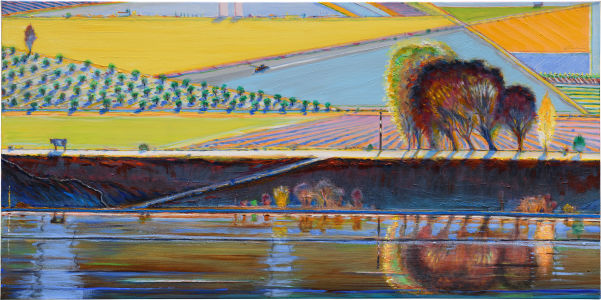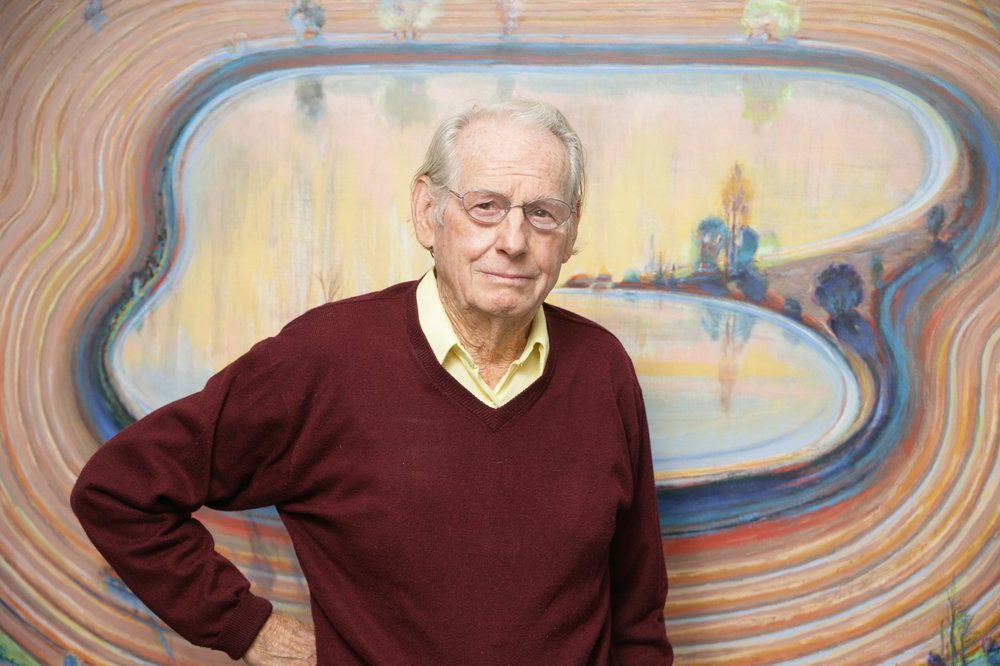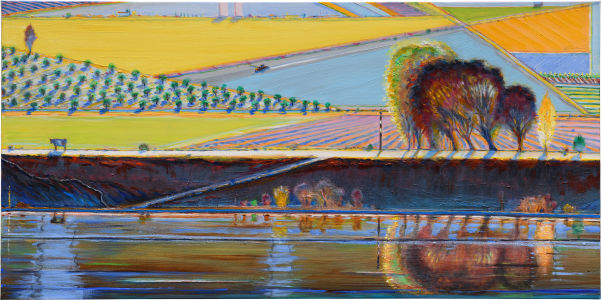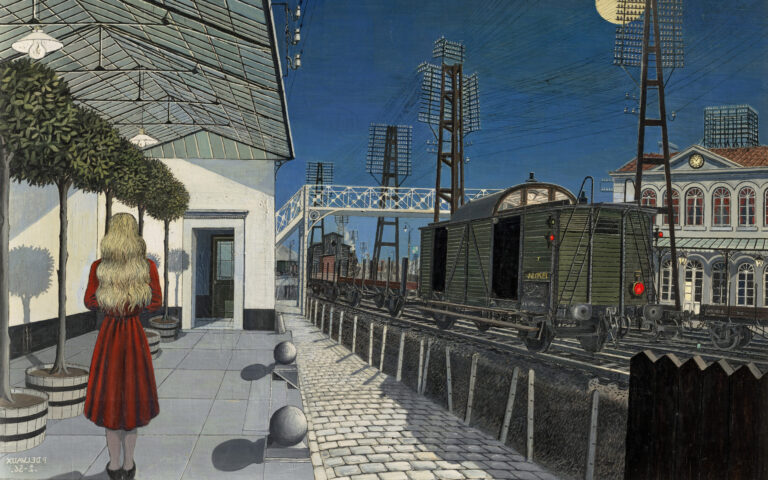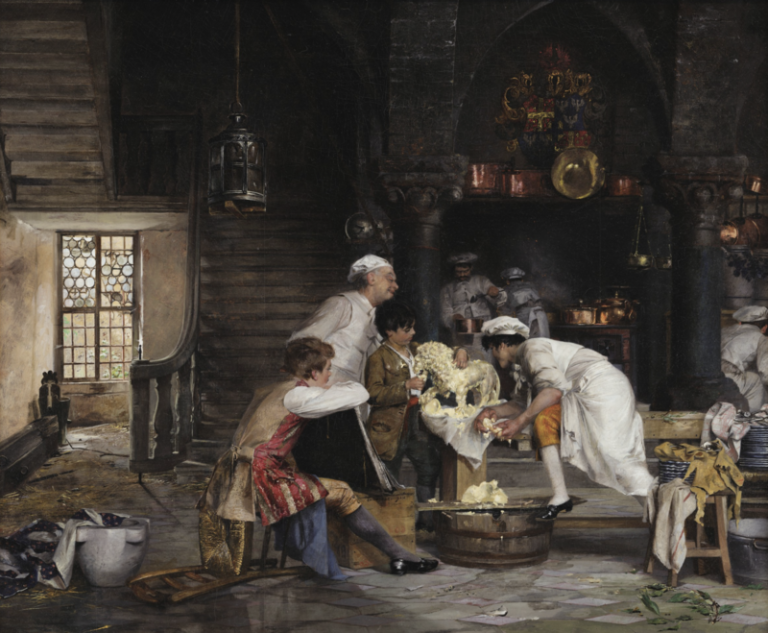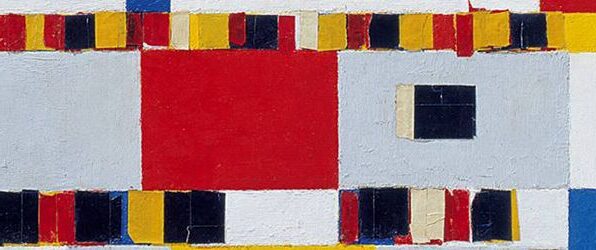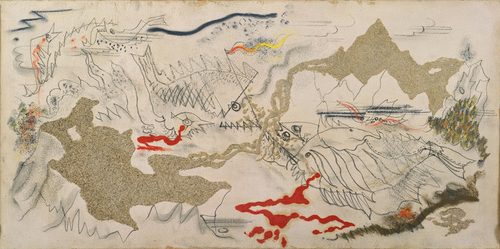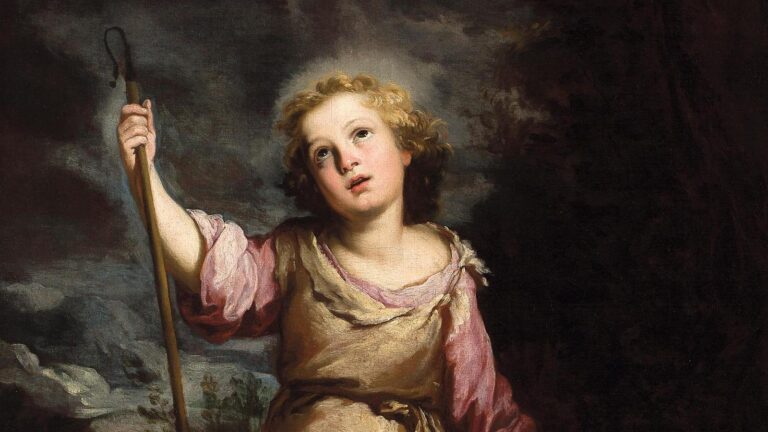Wayne Thiebaud, Painter: A Master of American Pop Art and Realism
Born: November 15, 1920, Mesa, Arizona, U.S.
Death: December 25, 2021, Sacramento, California, U.S.
Art Movement: Pop Art, New Realism, Bay Area Figurative Movement
Nationalité : Américain
Influenced By: Robert Rauschenberg and Jasper Johns
Institution: Sacramento State College, San Jose State College, Sacramento State
Wayne Thiebaud, Painter: A Master of American Pop Art and Realism
Biography of Wayne Thiebaud
Wayne Thiebaud transformed from a commercial artist to one of America’s most distinctive painters. He is known for his vibrant still lifes of everyday objects.
Vie et éducation précoces
Wayne Thiebaud was born on November 15, 1920, in Mesa, Arizona. His family moved to Long Beach, California during his childhood, where he developed an early interest in the arts, particularly theater and visual expression.
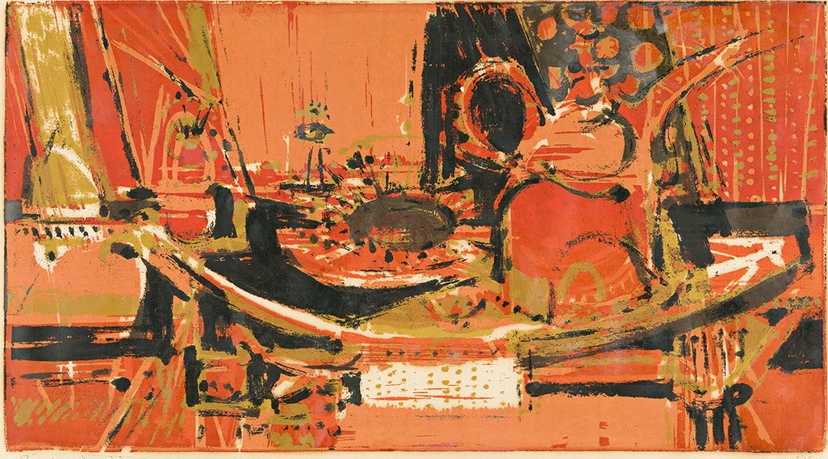
Persian Still Life, 1956, by Wayne Thiebaud
As a teenager, Thiebaud worked at Disney Studios as an animator and later designed movie posters for Universal Pictures. This commercial art experience influenced his later painting style and subject choices.
His formal education began at San Jose State University (then San Jose State College), where he studied art. He later attended Sacramento State College (now California State University, Sacramento), building a foundation in fine arts that would shape his future work.
Military Service and Artistic Foundations
During World War II, Thiebaud served in the United States Army Air Forces from 1942 to 1945. He worked in the Special Services division, where he created cartoons for military newspapers and designed posters.
This military experience proved formative for his artistic development. While serving, he continued to paint and draw, refining his skills and distinctive style. The precision and attention to detail required in his military work carried over into his later paintings.
After the war, Thiebaud returned to Sacramento and worked as a designer and illustrator. He began to transition from commercial art to fine art painting during this period, developing his signature style of depicting everyday American objects with thick paint and bold colors.
Academic Career and Teaching
In 1960, Thiebaud joined the art faculty at the University of California, Davis, where he taught for nearly 30 years until his retirement in 1991. He became a beloved professor known for his dedication to teaching fundamental artistic principles.
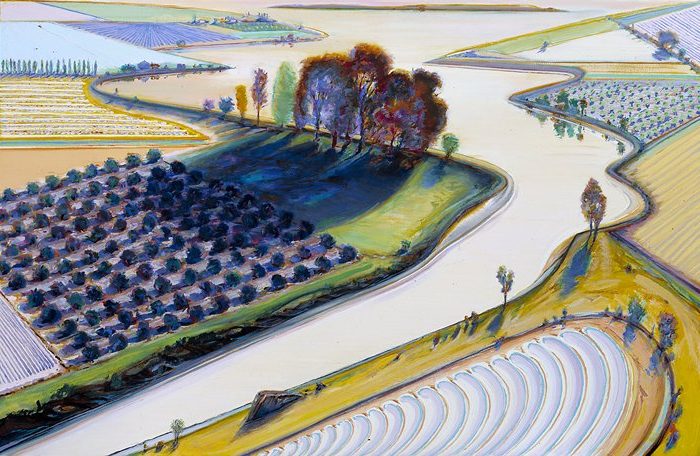
Flatland River, 1997, by Wayne Thiebaud
At UC Davis, he influenced generations of artists while continuing to develop his own distinctive painting style. His academic career coincided with his rising prominence in the art world following his first major exhibition in New York in 1962.
Thiebaud maintained studios in both Sacramento and San Francisco, dividing his time between teaching and painting. His commitment to education extended beyond UC Davis through guest lectures and workshops throughout California and beyond. He believed strongly in teaching traditional artistic techniques as the foundation for creative expression.
Style artistique et œuvres majeures
Wayne Thiebaud developed a distinctive artistic style marked by vibrant colors, thick paint application, and nostalgic representations of everyday objects. His technical precision and unique approach to composition earned him recognition in the American art scene from the 1960s onwards.
Pop Art Influences and Realist Techniques
Though often associated with Pop Art due to his focus on consumer goods, Thiebaud maintained that his work drew more from traditional painting. Unlike Pop artists who commented on mass production, Thiebaud painted from a place of genuine affection for his subjects. His technique involved applying paint thickly, creating a textured surface that mimics the frosting on the cakes he often depicted.
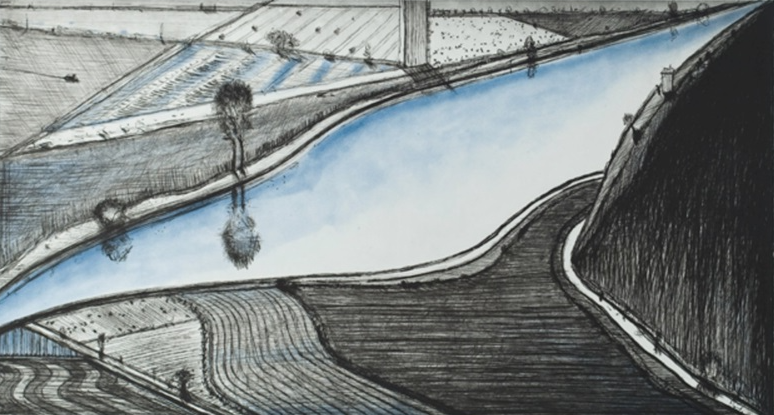
Dark Hill River, 2002, by Wayne Thiebaud
Thiebaud’s distinctive use of color included bright, saturated hues and exaggerated shadows that gave his paintings a vibrant, almost theatrical quality. He employed what he called “halation” – surrounding objects with rainbow-like bands of color to create a glowing effect.
His work drew inspiration from artists like Chardin and Morandi, demonstrating his connection to traditional still life painting while developing his unique contemporary style.
Iconic Paintings of Food and Objects
Thiebaud’s most recognizable works feature rows of meticulously painted desserts – cakes, pies, ice cream, and candies arranged as if in a diner display case. “Cakes” (1963) and “Pies, Pies, Pies” (1961) showcase his ability to transform ordinary objects into compelling art through careful attention to light, shadow, and texture.
Beyond desserts, Thiebaud painted various everyday items including lipsticks, paint cans, and gumball machines. These objects are presented with a sense of dignity and subtle nostalgia that elevates the mundane.
His compositions typically feature simple arrangements against plain backgrounds, allowing the objects themselves to command attention. The thick application of oil paint gives these works a tactile quality that makes the food items appear deliciously tangible.
California Landscapes and Cityscapes
In the 1970s, Thiebaud expanded his subject matter to include dramatic California landscapes and San Francisco cityscapes. These works feature exaggerated perspectives and impossible gravity, with streets appearing to plunge at vertigo-inducing angles.
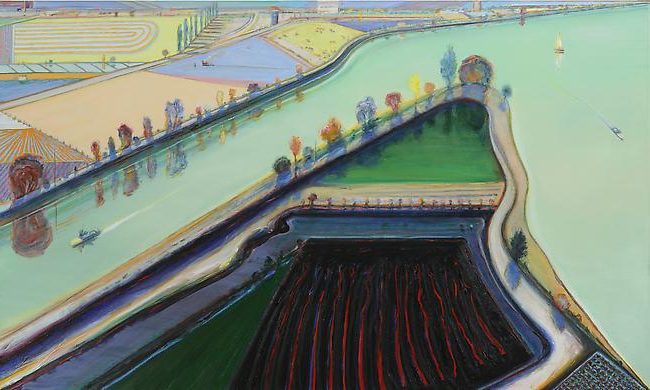
River Boats, 2001, by Wayne Thiebaud
His landscape paintings like “River Intersection” (2010) show winding waterways cutting through farmland with a bird’s-eye perspective that flattens and abstracts the terrain. The fields appear as geometric color blocks, creating a patchwork effect.
Thiebaud’s cityscapes capture San Francisco’s unique topography with compressed space and heightened colors. Buildings stack improbably on steep hills, creating dreamlike urban environments that blend reality with imagination.
Expansion into Prints and Drawings
Throughout his career, Thiebaud explored printmaking techniques including etching, lithography, and screen printing. His prints maintain the same careful attention to composition and subject matter found in his paintings but often with a more simplified approach.
Thiebaud’s drawings reveal his exceptional draftsmanship, often executed with minimal lines that capture the essence of his subjects. These works demonstrate his foundation in illustration and design that predated his fine art career.
Many of his prints focus on the same subjects as his paintings – desserts, objects, and landscapes – but the different medium allows for unique textural qualities and tonal variations. The “Delights” portfolio (1964) features lithographs of ice cream cones and sundaes that showcase his ability to translate his distinctive style across different media.
Impact culturel et héritage
Wayne Thiebaud’s distinct artistic vision has shaped American art in profound ways. His colorful depictions of everyday objects and California landscapes have secured his place in art history while influencing generations of artists.
Influence on American and California Art
Thiebaud’s unique approach to American imagery created a lasting impact on the art world. Though often associated with Pop Art, he maintained his independence from specific movements, developing a signature style characterized by thick paint, bold colors, and distinctive shadows. His California landscapes, with their dramatic perspectives and vibrant hues, defined a distinctly West Coast aesthetic.
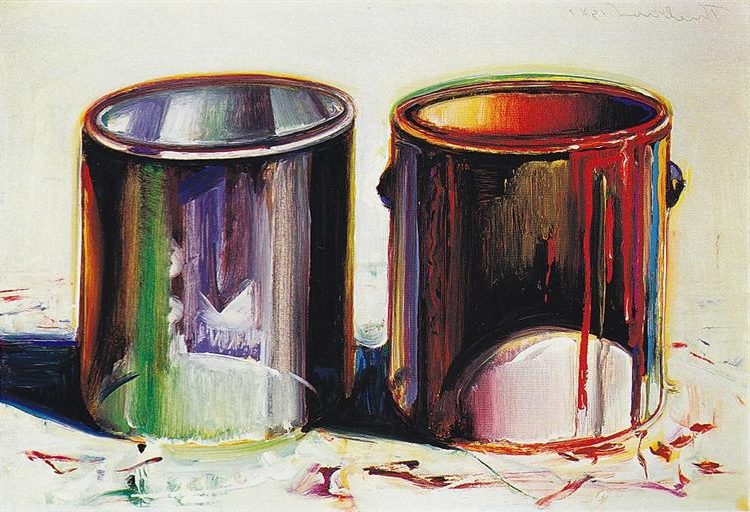
Two Paint Cans, 1987, by Wayne Thiebaud
As a professor at the University of California, Davis for over 40 years, Thiebaud mentored countless artists. His teaching philosophy emphasized traditional techniques while encouraging individual expression.
Many contemporary painters cite Thiebaud’s treatment of sujets ordinaires—gumball machines, ice cream cones, and cakes—as inspiration for finding beauty in the commonplace.
Representations in Major Art Institutions
Thiebaud’s works are featured in prestigious collections worldwide. The Crocker Art Museum in Sacramento houses a significant collection of his paintings, highlighting his connection to California.
The National Gallery of Art in Washington, DC maintains numerous Thiebaud works, recognizing his importance to American art history. His paintings are also prominently displayed at the Whitney Museum, Museum of Modern Art, and San Francisco Museum of Modern Art.
Major retrospectives of his work have consistently drawn large audiences. These exhibitions typically showcase his evolution from commercial artist and cartoonist to fine art painter, tracing his development across decades.
The value of Thiebaud’s paintings has increased dramatically over time, with some works selling for millions at auction.
Tributes and Honors
Thiebaud received numerous awards throughout his career, including the National Medal of Arts in 1994, America’s highest artistic honor. He was elected to the American Academy of Arts and Letters, recognizing his contributions to culture.
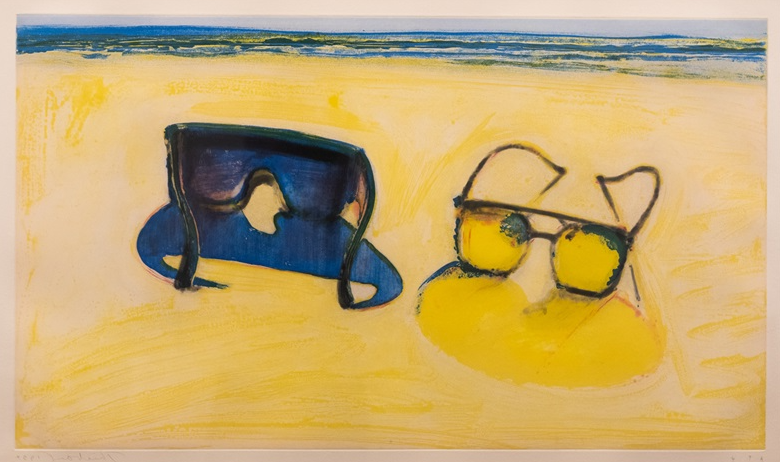
Beach Glasses, 1994, by Wayne Thiebaud
Several documentaries have explored his life and artistic process, bringing his methods to wider audiences. His 100th birthday in 2020 sparked celebrations and special exhibitions nationwide.
After his death on Christmas Day 2021, tributes poured in from artists, museums, and public figures acknowledging his gentle character and cheerful artistic legacy. Many emphasized how his work transformed ordinary American experiences into extraordinary visual celebrations.
The Wayne Thiebaud Foundation continues his legacy by supporting arts education and preserving his artistic contributions.
Questions fréquemment posées
Wayne Thiebaud’s unique artistic approach has sparked many questions among art enthusiasts and critics alike. His distinctive style, subject choices, and technical methods have made him one of America’s most recognizable painters.
What distinguishes Wayne Thiebaud’s artwork in terms of style and technique?
Thiebaud is known for his thick, luscious application of paint, often called “impasto.” This technique gives his paintings a three-dimensional quality, making his subjects appear to rise from the canvas.
His color palette features bright, saturated hues with strong contrasts. He often outlines objects with multiple colors, creating a vibrating effect at the edges.
Thiebaud’s work is characterized by strong shadows and exaggerated perspectives. He applies paint precisely, giving ordinary objects a sense of monumentality and presence.
How has Wayne Thiebaud’s background influenced his painting subjects and themes?
Thiebaud’s early work experience in restaurants and food service directly influenced his iconic food paintings. His time as a commercial artist and cartoonist taught him to appreciate everyday American imagery.
His California upbringing shaped his artistic vision, particularly in his later landscape paintings that captured the state’s unique topography and light.
Thiebaud maintained that he wasn’t part of the Pop Art movement despite similar subject matter. His approach was more rooted in traditional painting practices and personal experience rather than commentary on consumer culture.
Can you identify some of the key characteristics of Wayne Thiebaud’s landscapes?
Thiebaud’s landscapes feature dramatic, sometimes impossible perspectives that compress space vertically. His river and delta scenes often show water paths cutting through agricultural land from a bird’s-eye view.
His city scenes, particularly of San Francisco, emphasize the steep inclines and dramatic angles of urban streets. These paintings play with gravity and spatial relationships in ways that feel both familiar and disorienting.
Thiebaud’s landscapes use the same rich color application as his still lifes, with vibrant shadows and glowing light effects that transform ordinary scenes into something magical.
What are some notable achievements and milestones in Wayne Thiebaud’s career as a painter?
Thiebaud enjoyed remarkable longevity as an artist, continuing to paint into his 100s before passing away on Christmas Day. His career spanned more than 80 years of active painting and teaching.
He received numerous awards including the National Medal of Arts and was elected to the American Academy of Arts and Letters. Major retrospectives of his work have been held at prestigious institutions including the Whitney Museum of American Art.
Despite his success, Thiebaud maintained a teaching position at the University of California, Davis for decades, influencing generations of artists while developing his own practice.
How does Wayne Thiebaud’s depiction of everyday objects challenge traditional art genres?
Thiebaud elevated common objects like pies, cakes, and lipsticks to subjects worthy of serious artistic attention. By painting these items with the same care traditionally reserved for landscapes or portraits, he challenged art hierarchies.
His work exists in a space between realism and abstraction. While recognizable, his subjects are idealized versions that exist in a realm of memory rather than strict representation.
Thiebaud rejected being categorized as a Pop artist, instead viewing his work as part of a longer tradition of American painting that celebrated ordinary life and accessible subjects.
What has contributed to the appreciation and value of Wayne Thiebaud’s works in the art market?
Thiebaud’s instantly recognizable style and appealing subject matter have made his work popular with both casual viewers and serious collectors. His paintings offer both visual pleasure and conceptual depth.
His relatively limited output compared to some contemporaries has increased demand for his works. Thiebaud was methodical and thoughtful in his production, and this has made original paintings particularly prized.
The artist’s long career and consistent quality have established his place in American art history. Major museums worldwide include his paintings in their permanent collections, further cementing his reputation and market value.

